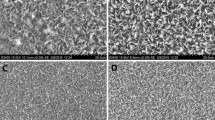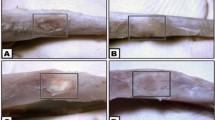Abstract
It is uncertain whether the use of bioactive bone cement has any beneficial effect on local bone adaptation following hip replacement. In this study, twelve goats underwent cemented hip hemiarthroplasty unilaterally, with either PMMA bone cement or strontium-containing hydroxyapatite (Sr-HA) bioactive bone cement. Nine months later, the femoral cortical bones at different levels were analyzed by microhardness testing and micro-CT scanning. Extensive bone remodeling was found at proximal and mid-levels in both PMMA and Sr-HA groups. However, with regard to the differences of bone mineral density, cortical bone area and bone hardness between implanted and non-implanted femur, less decreases were found in Sr-HA group than PMMA group at proximal and mid-levels, and significant differences were shown for bone area and hardness at proximal level. The results suggested that the use of Sr-HA cement might alleviate femoral bone remodeling after hip replacement.





Similar content being viewed by others
References
Shorr E, Carter AC. The usefulness of strontium as an adjuvant to calcium in the remineralization of the skeleton in man. Bull Hosp Jt Dis Orthop Inst. 1952;13:59–66.
Takahashi N, Sasaki T, Suda T, Tsouderos Y. S 12911-2 inhibits osteoclastic bone resorption in vitro. J Bone Miner Res. 2003;18:1082–7.
Baron R, Tsouderos Y. In vitro effects of S12911-2 on osteoclast function and bone marrow macrophage differentiation. Eur J Pharmacol. 2002;450:11–7.
Canalis E, Hott M, Deloffre P, Tsouderos Y, Marie PJ. The divalent strontium salt S12911 enhances bone cell replication and bone formation in vitro. Bone. 1996;18:517–23.
Barbara A, Delannoy P, Denis BG, Marie PJ. Normal matrix mineralization induced by strontium ranelate in MC3T3-E1 osteogenic cells. Metabolism. 2004;53:532–7.
Delannoy P, Bazot D, Marie PJ. Long-term treatment with strontium ranelate increases vertebral bone mass without deleterious effect in mice. Metabolism. 2002;51:906–11.
Modrowski D, Miravet L, Feuga M, Marie PJ. Increased proliferation of osteoblast precursor cells in estrogen-deficient rats. Am J Physiol. 1993;264(2 pt 1):E190–6.
Hott M, Deloffre P, Tsouderos Y, Marie PJ. S12911-2 reduces bone loss induced by short-term immobilization in rats. Bone. 2003;33:115–23.
Meunier PJ, Roux C, Seeman E, Ortolani S, Badurski JE, Spector TD. The effects of strontium ranelate on the risk of vertebral fracture in women with postmenopausal osteoporosis. N Engl J Med. 2004;350:459–68.
Marie PJ. Strontium ranelate: a physiological approach for optimizing bone formation and resorption. Bone. 2006;38:S10–4.
Johal KK, Mendoza-Suarez G, Escalante-Garcia JI. In vivo response of strontium and zince-based ionomeric cement implants in bone. J Mater Sci: Mater Med. 2002;13:375–9.
Christoffersen J, Christoffersen MR, Kolthoff N. Effects of strontium ions on growth and dissolution of hydroxtapatite and on bone mineral detection. Bone. 1997;20:47–52.
Chen DM, Fu YF, Gu GZ. Preparation and solubility of the solid solution of strontium substituted hydroxyapatite. Chin J Biomed Eng. 2003;20:278–82.
Chen DM, Fu YF. Evaluation on the mechanic properties of the solid solution of strontium substituted hydroxyapatite. Chin J Stoma Mater Appar. 2001;19:178–83.
Duncan C, Masterson E, Masri B. Impaction allografting with cement for the management of femoral bone loss. Orthop Clin North Am. 1998;29:297–305.
Li YW, Leong JCY, Lu WW, Luk KDK, Cheung KMC, Chiu KY, et al. A novel injectable bioactive bone cement for spinal surgery: a development and preclinical study. J Biomed Mater Res. 2000;52:164–70.
Ni GX, Lu WW, Chiu KY, Li ZY, Fong DY, Luk KD. Strontium-containing hydroxyapatite (Sr-HA) bioactive cement for primary hip replacement: an in vivo study. J Biomed Mater Res. 2006;77B:409–15.
Wong CT, Lu WW, Chan WK, Cheung KMC, Luk KDK, Lu DS, et al. In vivo cancellous bone remodeling on a strontium-containing hydroxyapatite (Sr-HA) bioactive cement. J Biomed Mater Res. 2004;68A:513–21.
Ni GX, Lu WW, Xu B, Chiu KY, Yang C, Li ZY, et al. Interfacial behaviour of strontium-containing hydroxyapatite cement with cancellous and cortical bone. Biomaterials. 2006;27:5127–33.
Chen QZ, Wong CT, Lu WW, Cheung KMC, Leong JCY, Luk KDK. Strengthening mechanism of bone bonding to crystalline hydroxyapatite in vivo. Biomaterials. 2004;25:4243–54.
Ni GX, Lu WW, Chiu KY, Wang Y, Li ZY, Zhang YG, et al. Mechanical properties of femoral cortical bone following cemented hip replacement. J Orthop Res. 2007;25(11):1408–14.
Freeman MAR, Bradley GW, Revell PA. Observation upon the interface between bone and polymethylmethacrylate cement. J Bone J Surg. 1982;64B:489–93.
Jasty M, Maloney WJ, Bragdon CR, Haire T, Harris WH. Histomorphological studies of the long-term skeletal responses to well fixed cemented femoral component. J Bone J Surg. 1990;72A:1220–5.
Harper EJ. Bioactive bone cements. Proc Instn Mech Engrs. 1998;212:113–8.
Huiskes R. The various stress patterns of press-fit, ingrown, and cemented femoral stems. Clin Orthop. 1990;261:27–38.
Oh I, Harris WH. Proximal strain distribution in the loaded femur. J Bone Joint Surg. 1978;60A:75–85.
Silva MJ, Reed KL, Robertson DD, et al. Reduced bone stress as predicted by composite beam theory correlates with cortical bone loss following total hip arthroplasty. J Orthop Res. 1999;17:525–31.
Bobyn JD, Glassman AH, Goto H, Krygier JJ, Miller JE, Brooks CE. The effect of stem stiffness on femoral bone resorption after canine porous-coated total hip arthroplasty. Clin Orthop. 1990;261:196–213.
Engh CA, Bobyn JD. The influence of stem size and extent of porous coating on femoral bone resorption after primary cementless hip arthroplasty. Clin Orthop. 1988;231:7–28.
Fujita H, Matsuda Y, Iida H, et al. Evaluation of bioactive bone cement in canine total hip arthroplasty. J Biomed Mater Res. 2000;49:273–88.
Labella R, Braden M, Deb S. Novel hydroxyapatite-based dental composites. Biomaterials. 1994;15:1197–200.
Saito M, Muraoka A, Mori T, Sugano N, Hino K. Experimental studies on a new bioactive bone cement: hydroxyapatite composite resin. Biomaterials. 1994;15:156–60.
Liu YK, Park JB, Njus GO, Stienstra D. Bone-particle-impregnated bone cement: an in vitro study. J Biomed Mater Res. 1987;21:247–61.
Lewis G. Properties of acrylic bone cement: state of the art review. J Biomed Mater Res. 1997;38:155–82.
Xue W, Moore JL, Hosick HL, Bose S, Bandyopadhyay A, Lu WW, et al. Osteoprecursor cell response to strontium-containing hydroxyapatite ceramics. J Biomed Mater Res. 2006;79A:804–12.
Ni GX, Chiu KY, Lu WW, Wang Y, Zhang YG, Hao LB, et al. Strontium-containing hydroxyapatite bioactive bone cement in revision hip arthroplasty. Biomaterials. 2006;27:4348–55.
Acknowledgements
This project was partially supported by Fujian Young Talent Project (2007F3040).
Author information
Authors and Affiliations
Corresponding authors
Additional information
An erratum to this article can be found at http://dx.doi.org/10.1007/s10856-010-4033-5
Rights and permissions
About this article
Cite this article
Ni, G.X., Lin, J.H., Chiu, P.K.Y. et al. Effect of strontium-containing hydroxyapatite bone cement on bone remodeling following hip replacement. J Mater Sci: Mater Med 21, 377–384 (2010). https://doi.org/10.1007/s10856-009-3866-2
Received:
Accepted:
Published:
Issue Date:
DOI: https://doi.org/10.1007/s10856-009-3866-2




